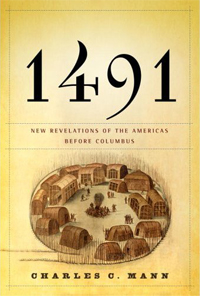I just finished 1491 by Charles C. Mann.
I am very impressed.
There’s a lot to unpack in the book but fundamentally, it lays bare an assumption that I never realized I was making. One that I think we are taught continually in American culture.
I think it’s best phrased the following way as a sort of logic proposition.
- We know that in the “Old World” that humans put their mark everywhere they touched. It shows everywhere. In cities. In fields. In old monuments.
- We know that that humans are intrinsically the same. That is, all humans share the same capabilities of cognition, dexterity, etc. We express it different ways but one of the fundamental traits of being human is our ability to shape the environment to ourselves.
- Why should we ever consider “New World” humans any differently?
Once this proposition is exposed—and the obvious
answer is that “New World” humans are not
different—we have to look at the landscape differently. I.e., the “wilderness”
we think of was not a wilderness at all. It was sculpted every bit as much as
the “Old World”—differently, of course. Humans in the Americas had a different
tool set than those in Africa, Europe and Asia and thus we can expect different
outcomes. But that’s a difference in quality not quantity.
(For purposes of this discussion I’m going to
follow Mann’s utilization of the word “Indian” to describe pre-Columbian
natives of the America’s. He has a long chapter where he explains why he chose
that word. Since he used it, and I’m talking about his work, I’m going to use
it here.)
The reason that Europeans came up with the idea
that the land they saw was “natural” was that by the time they explored it, the
land was empty. Most of the native population died of introduced diseases long
before they saw a European. The empty land was full of game and plentiful
fruits and nuts—a natural paradise. Except it wasn’t natural at all. Europeans
reaped the harvest without ever knowing how cultivated it was.
There’s a certain foreshortening of history that I
think Americans are susceptible to. We have incredibly short attention spans
and cling to myths and beliefs against all evidence. One of the problems with
the American visualization of native populations is how it’s is based on a very
narrow window of time. American imagery comes from the Time of the West—the
forty years or so after the Civil War and before 1900. The remainder think
about Thanksgiving but when they do, often they conflate the two, dressing the Indians
in garb from two hundred years later and a thousand miles away.
The history between 1492 and the present—better
than five hundred years—is, of course, much broader than that. The Indians
didn’t all die at once—there were long stretches of time where there was significant
comingling of the cultures. But vast numbers did die.
There’s one story that rung out for me: the story
of Tisquantum who has become known as Squanto in the Pilgrim story. Tisquantuam
was kidnapped to Spain about 1614 and spent several years attempting to return.
When he left his village and the other villages in the area around Plymouth
were vibrant and numerous. The coastal area was heavily populated all the way
up into Main.
When he returned, it was
desolate. His home village was gone. Where there had been tens of thousands
there were not tens. The Pilgrims had squatted in the ruins of his old village.
Tisquantum ended up living with them. Did he live there because this was the
only thing that remained of his old life? Because after his time away, and this
terrible loss, he ended up having more in common with those that lived in the
ruins than the remainder of other tribes?
Mann tells these sorts of stories all through the
Americas from Canada down to the tip of South America. Ecological triumphs such
as the mispas—areas of combined
cultivation of maize, squash and legumes where the heavy feeders (maize) pulled
nitrogen from the soil that had been fixed from the atmosphere by the legumes.
Some areas had been continuously cultivated for hundreds of years.
There were also ecological failures. The Mound
Builders of Cahokia took to the introduction of maize with a vengeance and
nearly destroyed the clay soil. There are evidences of washouts when the
Mississippi flooded the area. Then, those washouts disappeared. The population
figured out what they had done wrong.
There are stories of the rise of cultures through
wonderful vision and the fall through nothing more than mean spiritedness in
interesting parallels to similar patterns in the Old World.
Man introduces a number of controversial points
and brackets them with the counter arguments and why he made his decisions. You
can argue with these points and you’ll be in good company—these arguments are
still going on as more and more evidence is being accumulated.
Even so, it changed my perspective and I welcome
that.
Highly recommended.



